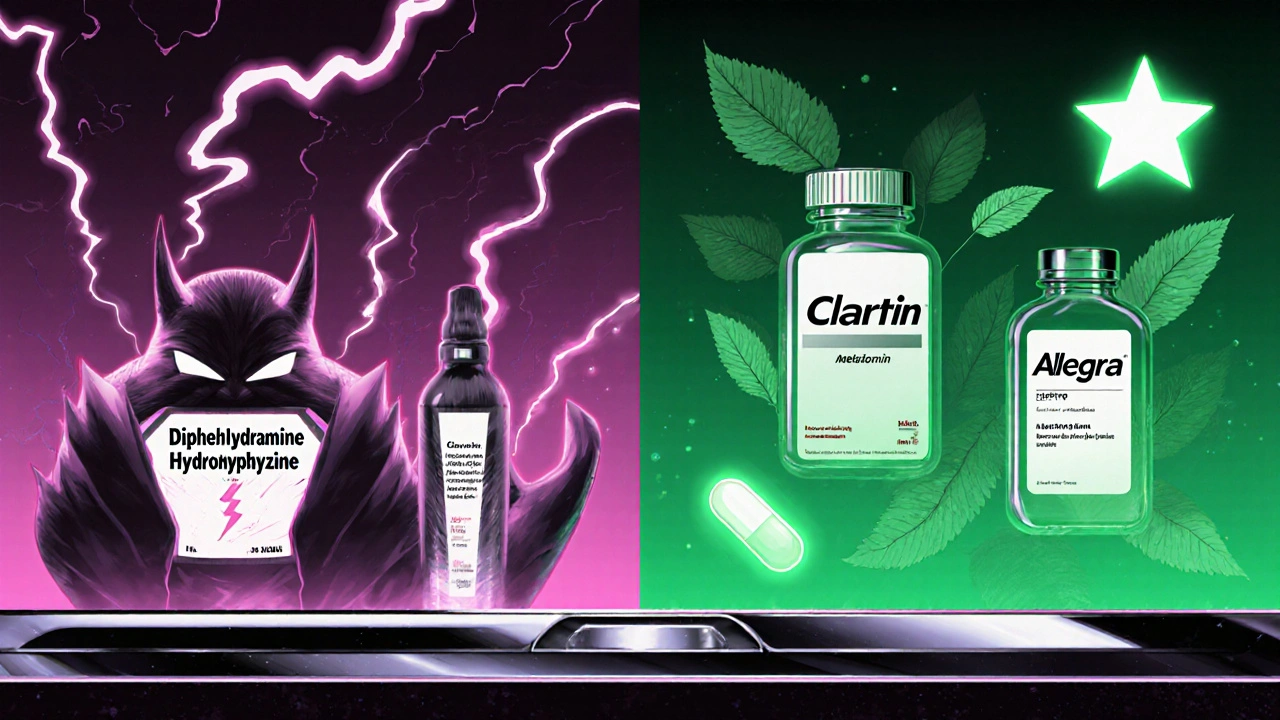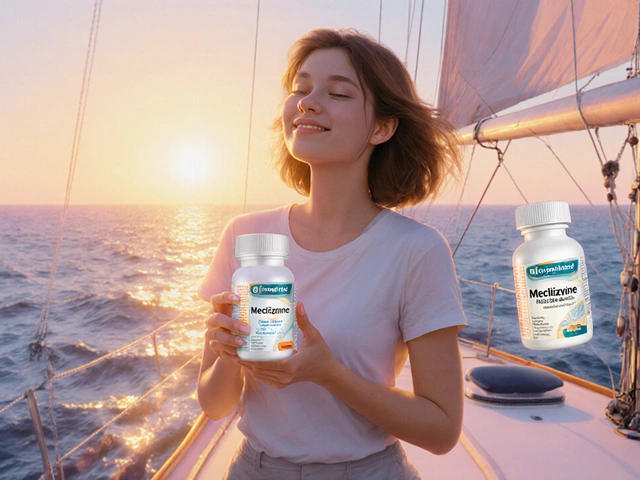Antihistamine Safety Checker
Check Your Medication Safety
Find out if your allergy, cold, or sleep medication contains ingredients that worsen restless legs syndrome (RLS)
Results
Enter a medication name to check its safety for restless legs syndrome
Many people reach for antihistamines like Benadryl when allergies hit-itchy eyes, runny nose, sneezing. But if you have restless legs syndrome (RLS), that quick fix could be making your nights unbearable. You’re not imagining it. Taking diphenhydramine, chlorpheniramine, or hydroxyzine can turn mild leg discomfort into a burning, crawling nightmare that keeps you awake for hours. The problem isn’t just coincidence-it’s biology.
Why Antihistamines Make Restless Legs Worse
| Antihistamine | Type | Brain Penetration | RLS Risk | Common Brand Names |
|---|---|---|---|---|
| Diphenhydramine | Sedating | High | Very High | Benadryl, Tylenol PM, Advil PM |
| Chlorpheniramine | Sedating | High | Very High | Piriton, Chlor-Trimeton |
| Hydroxyzine | Sedating | High | Very High | Atarax, Vistaril |
| Loratadine | Non-sedating | Low | Low | Claritin |
| Fexofenadine | Non-sedating | Very Low | Very Low | Allegra |
| Cetirizine | Non-sedating | Moderate | Moderate | Zyrtec |
Restless legs syndrome isn’t just about discomfort-it’s a neurological condition tied to dopamine, the brain’s movement and reward chemical. Sedating antihistamines like diphenhydramine cross the blood-brain barrier easily because they’re fat-soluble. Once inside, they don’t just block histamine-they accidentally block dopamine receptors too. That’s a double blow for RLS patients. Their brains already struggle with dopamine signaling, and now these medications make it worse.
Studies back this up. One analysis of over 16,000 kidney disease patients found those taking sedating antihistamines were nearly twice as likely to develop or worsen RLS symptoms. Another survey of 1,247 RLS patients showed 68% had their symptoms made worse by these drugs. In one case, a patient took Benadryl for allergies and couldn’t sleep for three nights straight-legs on fire, constant urge to move. Switching to Claritin cut symptoms in half within a day.
What Medications to Avoid
You can’t just avoid Benadryl. The real danger is hidden in plain sight. Many over-the-counter cold, flu, and sleep aids contain sedating antihistamines as inactive ingredients. Check labels for these names:
- Diphenhydramine
- Doxylamine
- Chlorpheniramine
- Hydroxyzine
- Promethazine
These show up in products like:
- Tylenol PM
- Advil PM
- Bayer PM
- Comtrex
- Contact
- Dimetapp
- TheraFlu
- Triaminic
- Vicks Cough and Cold
- Night Nurse cough syrup
Even if you’re not taking them for sleep, you might be. Some people use them for nausea, motion sickness, or even hives. One patient in a Houston Methodist survey didn’t realize her daily nausea pill contained hydroxyzine-until her RLS flared up so badly she had to walk around the house every 20 minutes.
And it’s not just antihistamines. Many of these combo products also include decongestants like pseudoephedrine or phenylephrine. These can make RLS worse too-up to 35% of patients report increased symptoms with these ingredients. So even if the antihistamine is safe, the whole pill might not be.
Safe Alternatives for Allergies and Sleep
The good news? You don’t have to suffer through allergy season. There are plenty of safe options.
Non-sedating antihistamines are your best bet. These barely enter the brain, so they don’t touch dopamine pathways:
- Loratadine (Claritin): Only 5% of RLS patients report worsening symptoms.
- Fexofenadine (Allegra): Lowest risk-under 5%. Often recommended as first choice.
- Desloratadine (Clarinex): Similar safety profile to loratadine.
Cetirizine (Zyrtec) is trickier. While it’s labeled non-sedating, about 15% of RLS patients still notice mild worsening. It’s not as bad as Benadryl, but it’s not risk-free. If you try Zyrtec and your legs feel worse, switch back to Allegra or Claritin.
For nasal symptoms, skip pills entirely. Use a nasal corticosteroid spray like fluticasone (Flonase). A 2019 study at Vanderbilt found 82% of RLS patients had fewer allergy symptoms and no increase in leg discomfort. Saline nasal rinses work too-76% of RLS patients in one survey found them helpful without any side effects.
If you need help sleeping because of allergies, try melatonin. It doesn’t affect dopamine. Studies show 65% of RLS patients sleep better with 0.5 to 5 mg of melatonin, with no worsening of symptoms. Avoid sleeping pills like zolpidem or zaleplon-they’re not safe either. They disrupt dopamine too.

What to Do If You’ve Already Taken a Problematic Drug
If you took Benadryl or something similar and your legs are screaming, don’t panic. The effects usually fade within 24 to 48 hours as the drug clears your system. In the meantime:
- Get up and walk around-movement helps.
- Apply heat or cold to your legs-some find relief with a warm bath or ice pack.
- Drink water and avoid caffeine or alcohol-they make RLS worse.
- Check your other meds. Iron deficiency can make RLS worse. Ask your doctor for a ferritin blood test.
Once the worst passes, switch to a safe antihistamine. Keep a list of safe and unsafe meds on your phone or in your wallet. Many RLS patients say this simple step changed their lives.
How to Read Labels Like a Pro
Pharmacies don’t always make it easy. The active ingredients are printed in tiny text. Here’s how to spot trouble:
- Look for the “Active Ingredients” section.
- Scan for the six dangerous names: diphenhydramine, doxylamine, chlorpheniramine, hydroxyzine, promethazine, or pseudoephedrine.
- If you see “PM,” “Night,” or “Sleep Aid” on the label-avoid it.
- Don’t assume “allergy” means safe. Zyrtec is safe. Benadryl is not. Same purpose, different risk.
- When in doubt, ask a pharmacist. They can check the label for you in seconds.
One patient in Wellington, New Zealand, told her story on an RLS forum: “I bought a cold medicine because I thought ‘non-drowsy’ meant safe. It had doxylamine. My legs felt like they were being electrocuted. I spent three nights sitting upright. Now I always check the label twice.”

Why This Matters More Than You Think
RLS affects about 1 in 10 adults. Many don’t know they have it-or they think it’s just “nerves.” But when a common allergy medicine makes it worse, it creates a cycle: poor sleep → more stress → worse symptoms → more meds → even worse sleep.
Doctors are catching on. The American Academy of Neurology updated its guidelines in 2021 to warn about antihistamines. Medicare now covers non-sedating antihistamines for nearly all patients. Sales of safe options like Allegra and Claritin have grown 12% in the last six years. Meanwhile, Benadryl sales are slowly falling.
This isn’t just about comfort. It’s about sleep. It’s about mental health. It’s about not being trapped in your own body every night. The fix isn’t complicated. It’s just hidden in the fine print.
Final Takeaway
If you have restless legs syndrome, you don’t need to give up on treating your allergies. You just need to be smarter about how you do it. Skip the sedating antihistamines. Choose Claritin, Allegra, or Flonase. Read every label. Talk to your pharmacist. Your legs-and your sleep-will thank you.






Holly Dorger
October 28, 2025 AT 14:06i took benadryl last week for my allergies and thought i was gonna lose my mind at 3am. my legs felt like they were full of ants crawling under my skin. i didnt even know it could do that. now i check every label like its a bomb.
Amanda Nicolson
October 29, 2025 AT 19:06oh my god this is so real. i used to take tylenol pm like it was candy because i thought ‘it’s just sleeping aid’-turns out it was also my nightly torture device. i went from sleeping 6 hours to 20 minutes a night. switched to claritin and suddenly i could breathe, move, and actually dream again. i cried in the pharmacy aisle. this isn’t just advice-it’s a lifeline.
Jackson Olsen
October 30, 2025 AT 22:20so benadryl = bad for rls. claritin = good. just check the label. simple. why do people make this so hard? 🤷♂️
Penny Clark
November 1, 2025 AT 10:16i had no idea zyrtec could still cause issues 😅 i thought ‘non-drowsy’ meant ‘safe’… turns out my legs were just being polite before they exploded. switched to allegra and now i can actually sleep without imagining my calves are trying to escape. also-flonase changed my life. no pills, no nightmares. just sniff and sleep 💆♀️
Niki Tiki
November 1, 2025 AT 23:49why do we need to baby people with rls? just stop taking dumb meds. if you cant read a label youre gonna die of allergies anyway. america is soft
Jim Allen
November 3, 2025 AT 08:50the real tragedy? we’re all just one pm pill away from becoming a screaming mess in our own skin. dopamine’s the real boss here and we’re all just pawns in a chemical game we didn’t even know we were playing. 🤯
Nate Girard
November 3, 2025 AT 23:47thank you for posting this. i’ve been dealing with this for years and never connected the dots. i thought it was just stress. now i know why my legs felt like they were on fire after every cold. i’m grabbing allegra on my way home. this might be the most helpful thing i’ve read all year.
Carolyn Kiger
November 4, 2025 AT 21:22just talked to my pharmacist and she showed me how to spot the bad ingredients in under 10 seconds. i’m printing this list and taping it to my medicine cabinet. small change, huge difference. thank you for making this so clear.
krishna raut
November 5, 2025 AT 04:35allegra works. no side effects. simple.
Prakash pawar
November 5, 2025 AT 05:45you think this is about meds? no. its about awareness. the system wants you sick so you keep buying pills. but the truth? your body knows. you just forgot to listen. read labels. trust yourself. dont let the pharma giants turn your legs into a warzone
MOLLY SURNO
November 6, 2025 AT 17:35This is an exceptionally well-researched and clearly presented overview. The distinction between sedating and non-sedating antihistamines is critical, and the inclusion of specific brand names and alternative treatments greatly enhances practical utility. Thank you for sharing this vital information with such care.